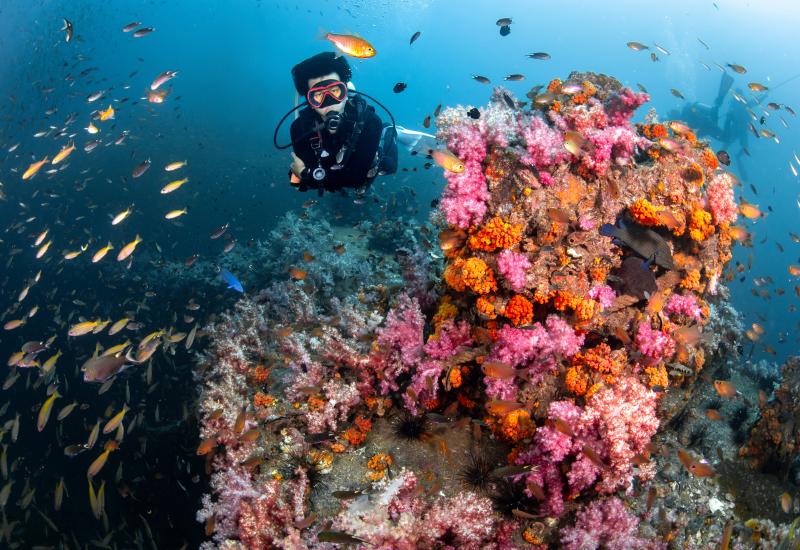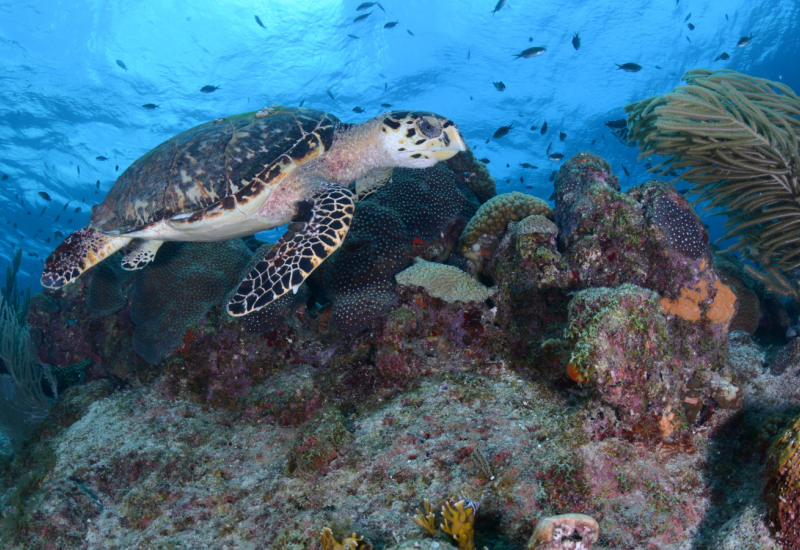Restoring Order to the Shark Populations of Cocos Island
The blood drains from my body before I see her. I sense her coming. Keeping my eyes fixed on a point between boulder and wall - an invisible river flowing up and over that just carried a lone hammerhead shark into view - I wait.
It’s our third dive at Manuelita Channel, one of the bigger draws at the remote outpost that is Cocos Island, more than 300 miles off mainland Costa Rica. Today marks day seven of my 10-day mid-October trip aboard Okeanos Aggressor I, one of two Aggressor liveaboards making the 36-hour crossing from Puntarenas.
We’ve been given one primary instruction at every predive briefing out here so far: Wait.
After all, the main reason to trek to Cocos is to see the big stuff, from scalloped hammerheads to manta rays. Out here, we live on their schedule.
But the wait is never long. I’ve only just settled onto the rocks at 70 feet deep when there she is. A female tiger shark, 12 feet long, and wide. Thick. Her attitude, her energy—only calm. She knows she rules these reefs. Her big round eye, a perfect circle of blackness, trained on me. She swims overhead with her mouth open and relaxed, and that eye swiveling back, back.
There’s a rattling. Warren Fernandez, Aggressor cruise director and 20-year Cocos dive guide, has signaled. I’m assuming he’s alerting the group to the tiger, about which most folks, back on the dive deck, were positively vibrating in excitement.
I stay watching the tiger until she disappears into the green plankton soup at the edge of view, some 50 feet away. Only then do I realize there are no other divers in sight. I’m alone.
Tigers in the Mix
I’ve just unintentionally broken the cardinal rule of Cocos: You and your buddy must stay with the dive group. Granted, I heard Fernandez signal and thought I knew what was happening. Because of the coming distraction, I mistook its meaning. I had assumed he was alerting the group to her arrival (as a tiger is something that he had signaled before on earlier dives). Later, I find out he was instead corralling the group to a deeper area to scout the open water.
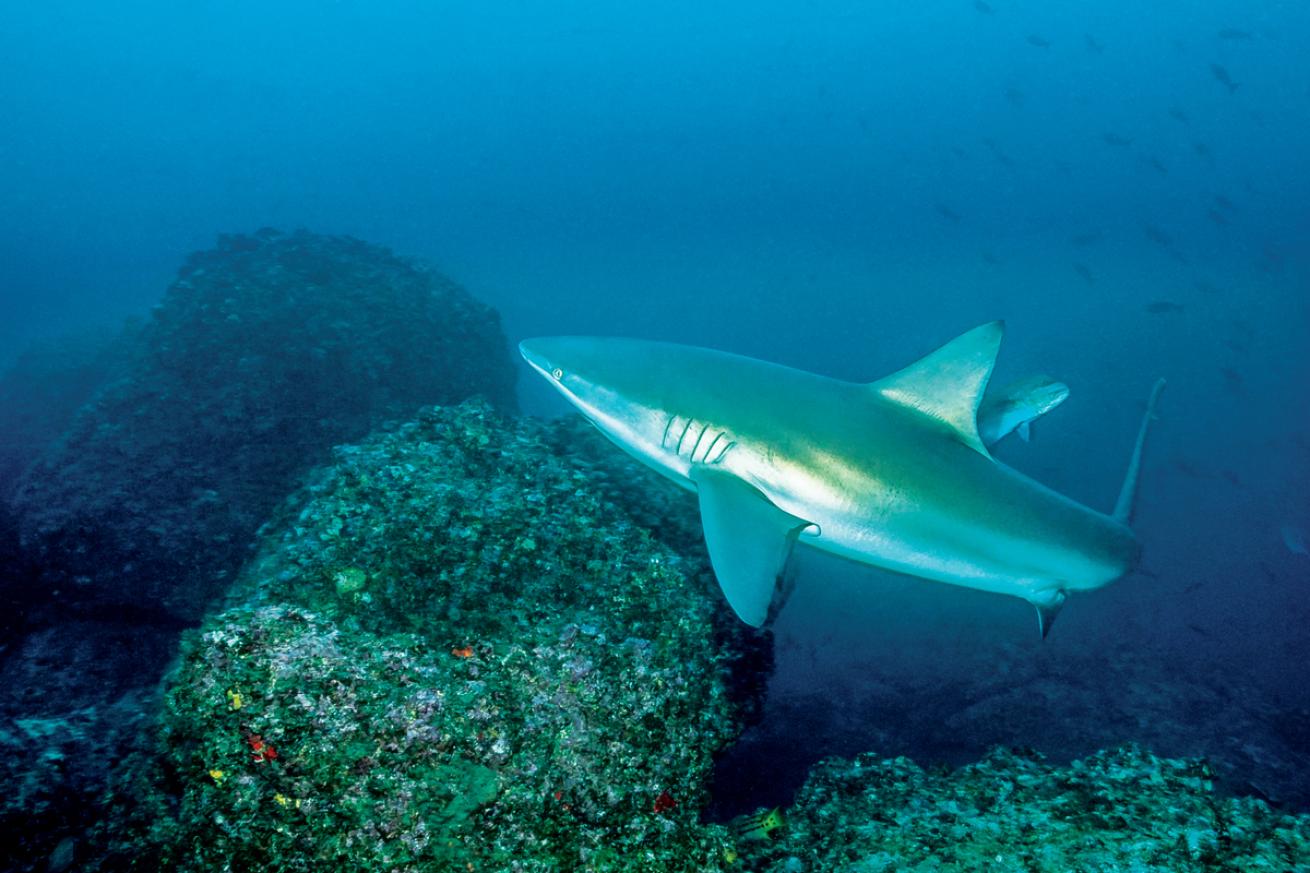
Tobias FriedrichA Galapagos shark
The stay-as-a-group rule is in place for several reasons. One, strong currents—even down-currents—aren’t the exception. They’re the norm.
But bigger than that is the tigers.
Only in 2009 did they arrive to Cocos. Or rather, it would be more accurate to say that only in 2009 did they return to the island.
Because Cocos is practically synonymous with hammerheads, it tends to receive a large spotlight when it comes to shark conservation—as it should. Media attention really heated up following the 2006 documentary film Sharkwater, which included scenes from Cocos.
By 2008, the president of Sector Palangrero Nacional, the longline fishermen’s association, was feeling the pressure from conservation groups and made a public announcement that longliners would back off the island, limiting their activity to 12 miles offshore. But before the fishermen’s announcement—and before the longliners even showed up—tigers, in fact, roamed Cocos waters. They’re naturally part of the ecosystem, which many divers might not realize.
The longliners’ arrival in the early ’80s shifted everything. Tigers come from all over the eastern tropical Pacific and concentrate in the waters surrounding Cocos Island, which was making it easy for fishermen to pick them off.
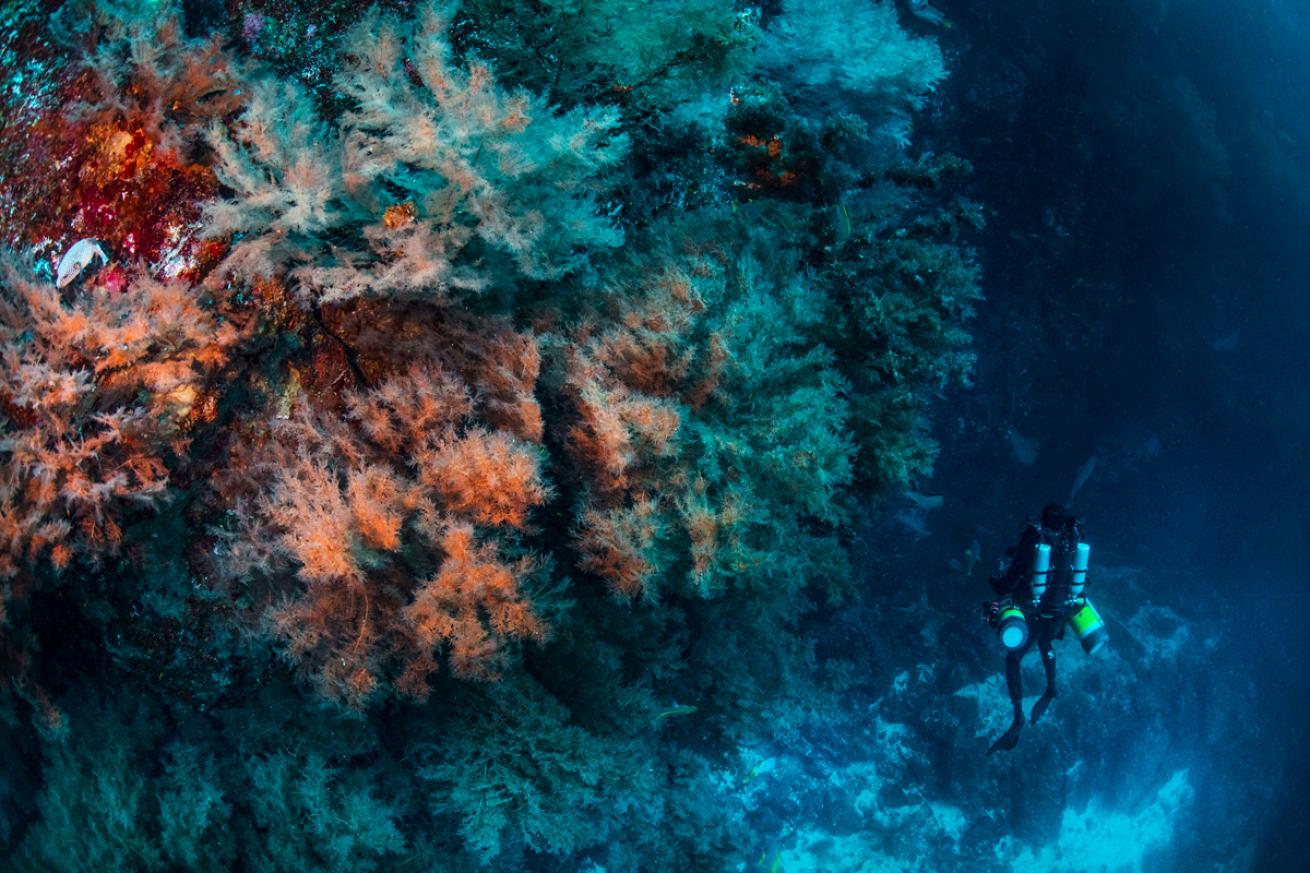
Becky SchottA towering wall of black coral.
As the tiger population dwindled, all the species the sharks had been consuming were suddenly given a chance to rebound. Among them, sea turtles.
Randall Arauz, marine conservation policy officer for Fins Attached Marine Research and Conservation, is today one of the leading shark experts on Cocos, having logged 53 trips spanning 16 years. But when he began diving Cocos in 2005—three years before the longliners backed away and the tigers returned—he was a turtle researcher, tagging as many as 30 sea turtles, mostly greens, on each of his trips.
That number plummeted as soon as the longliners pulled out of Cocos. “In no time at all, tigers showed up everywhere,” Arauz says.
Divers who returned to Cocos before and after the change couldn’t help but take note of the tigers—a big source of in-water excitement. Even Arauz admits to a certain rush when seeing this apex predator. “The adrenaline flows every time they swim by, sure,” he says. “Every one of these encounters is fascinating.”
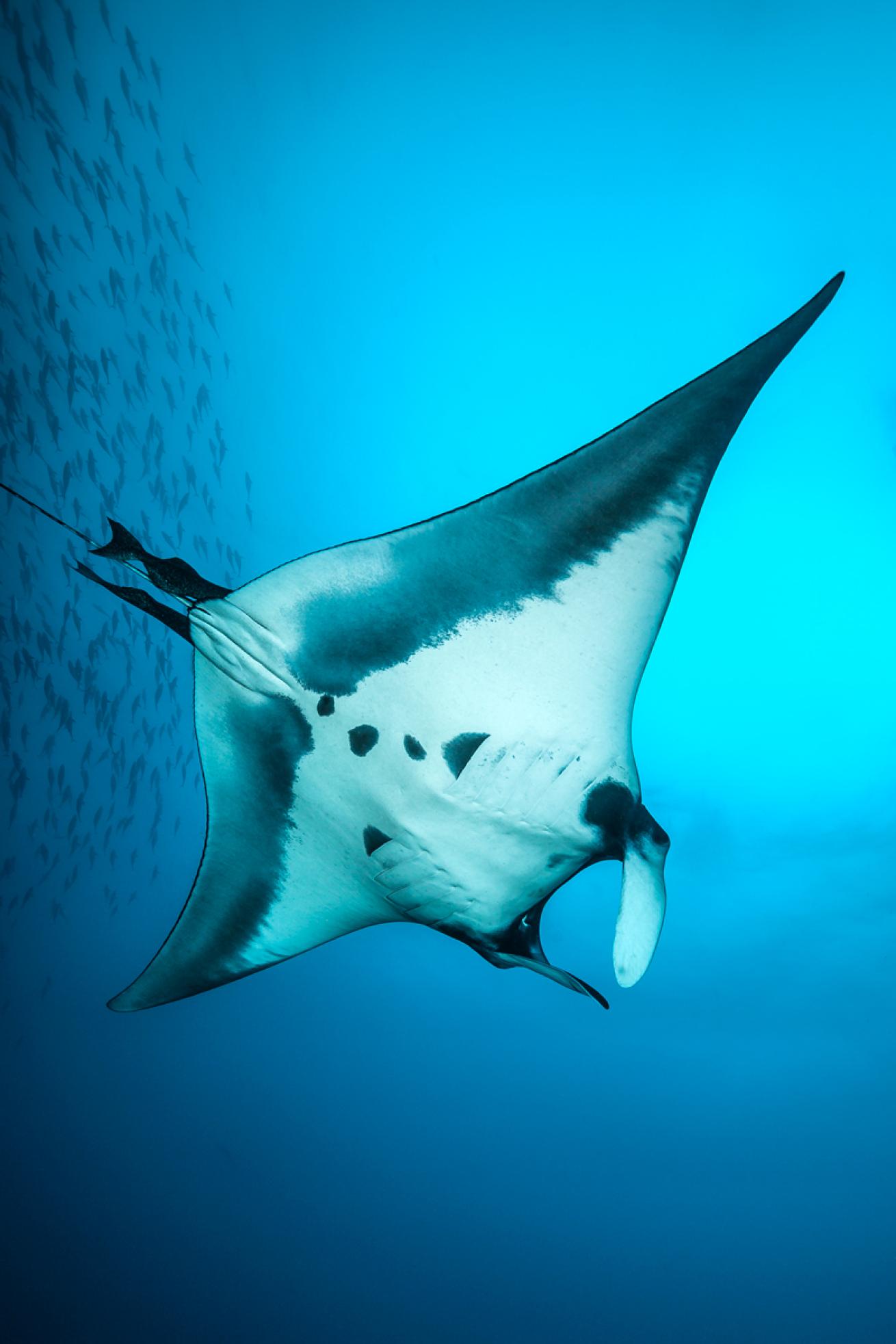
Tobias FriedrichSharks are only part of the equation. The waters off Cocos Island also attract giant mantas, and its reefs play host to colorful fish life.
But their re-entry wasn’t without consequences.
“They came, and almost overnight, we saw a steep decline in sea turtles, eagle rays and whitetips,” he says. “That’s because the tiger shark is the architect. He is the regulator of the environment, keeping all the species beneath him under check.”
As much as he appreciates the tiger sharks, Arauz acknowledges a feeling of sadness over the loss of turtles. “I was a turtle researcher first,” he says.
Most divers perhaps didn’t notice the absence of the turtles. Nor would they likely have known the politics behind it all—or the fact that Cocos is once again in the middle of a political fight that will affect its biggest draw of all: the hammerhead.
Reformed Finner
The next morning, I promise to do better at staying on the fin heels of Fernandez. The site we’re headed to, Alcyone, is named for the expedition vessel that first carried Jacques Cousteau here, and it’s known as one of the best spots in Cocos for schooling hammerheads. It’s 1 mile off the southern coast, a nearly 30-minute ride by Zodiac.
This site is exposed. As such, we have to double down on our hot drops. Every Cocos dive requires a negative entry: Deflate the BC, back-roll off the inflatable dinghy and descend as quickly as you can to the meeting depth. The difference with Alcyone is the current here is so much stronger that there’s a line in place to follow, hand over hand, until we reach 80 feet. The current is pumping.
Fernandez gets low, levitating behind a rock while facing the blue.
Up until now, we’ve seen six hammers at a time. Maybe 12. The schools circle back and often make several passes, making it feel like we’ve encountered higher numbers. On nearly every dive, we’ve seen hammers, normally such a “get” to encounter on a dive. In my 27 years of diving, I’ve only seen a handful—the great hammers off Bimini, yes, which are a different species, of course, and then just one hammerhead decades back in the Red Sea.
To spend a week seeing them is a gift. There’s a sensuality to their swimming— as if their midsections are beating out a slow hula, making the smallest, most efficient movements to stay in the current. Even just these encounters would warrant the travel here.
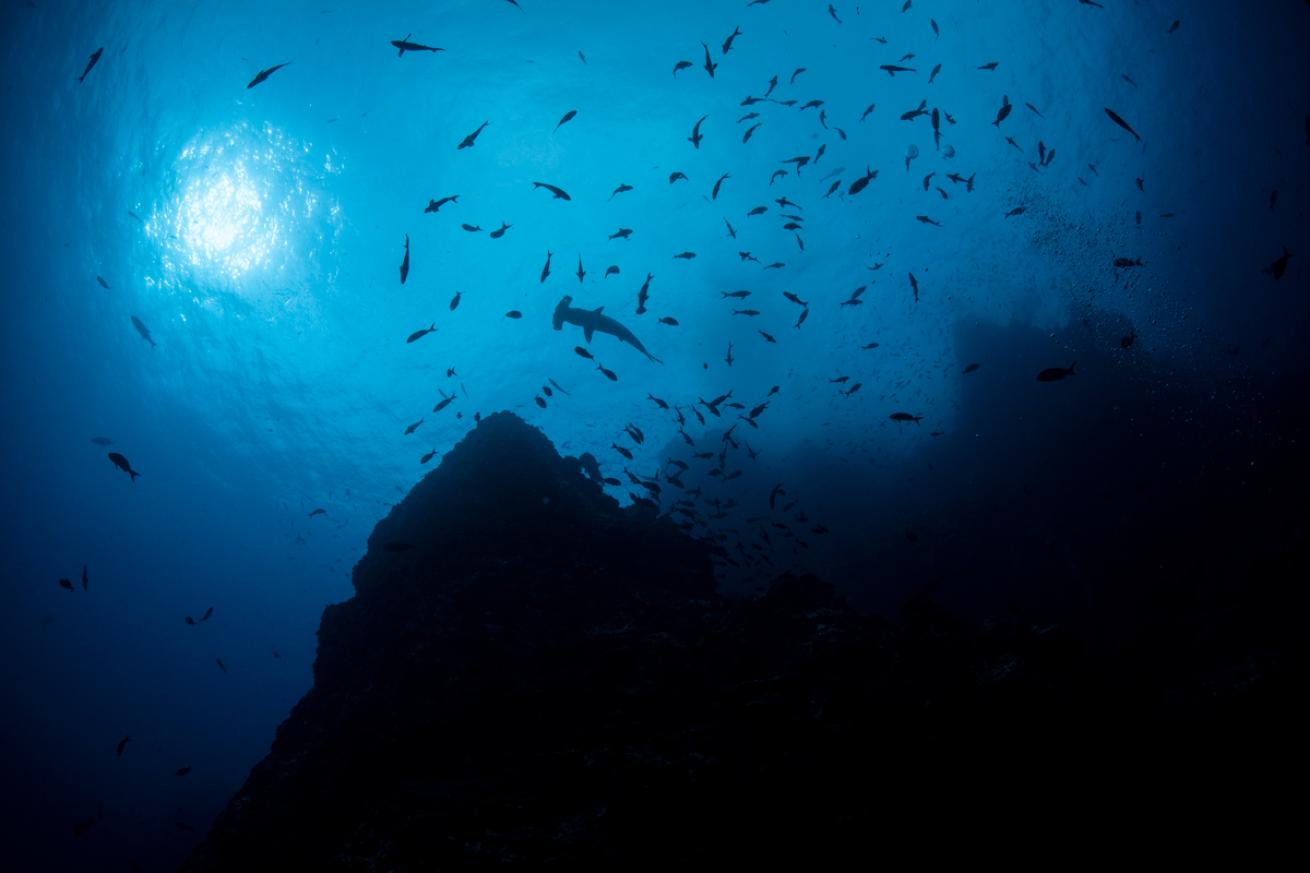
Becky SchottA hammerhead on patrol.
But then, boom. In silhouette, they’re above us. I count 20. No, 40. The group proves to be larger and larger with each second we watch. Now there are 60. This is the magic. They’re just about the only shark species that schools— reasons unknown—so this is a sight rarely experienced anywhere on the planet, with the exception of these few hotspots.
The sharks make a first pass, then another. Alcyone is an especially dynamic spot for encounters because the two rock walls meet at an acute angle, forming an arrowhead point that cuts into two currents. Because sharks swim against the current, this topography uniquely allows sharks to approach from two angles— thus many more encounters.
Back in Time
To dive Cocos is to know you’re in a magical place. After all, it was the inspiration for Michael Crichton’s novel Jurassic Park, through which it was possible for lizard geeks to travel back millennia and experience a lost era.
Fiction aside, there’s an undeniable magnetism to the destination—quite literally.
Back in the 1990s, turtle researcher Frank Paladino found, by putting satellite transmitters on leatherback turtles, that there was an oceanic corridor connecting Cocos Island to the Galapagos Islands of Ecuador.
More recently, shark researchers have found that hammerheads—along with tigers, silky sharks, Galapagos sharks and green turtles— also use this corridor.
Picture it: 3,000 feet deep is an underwater mountain range, the Submarine Cocos Ridge. The Rockies of the Pacific. Some of its peaks rise to within 600 feet of the surface. But here’s the wild part: The volcanic mountain range is magnetic, a veritable beacon sensed by these animals and used to navigate the ocean.
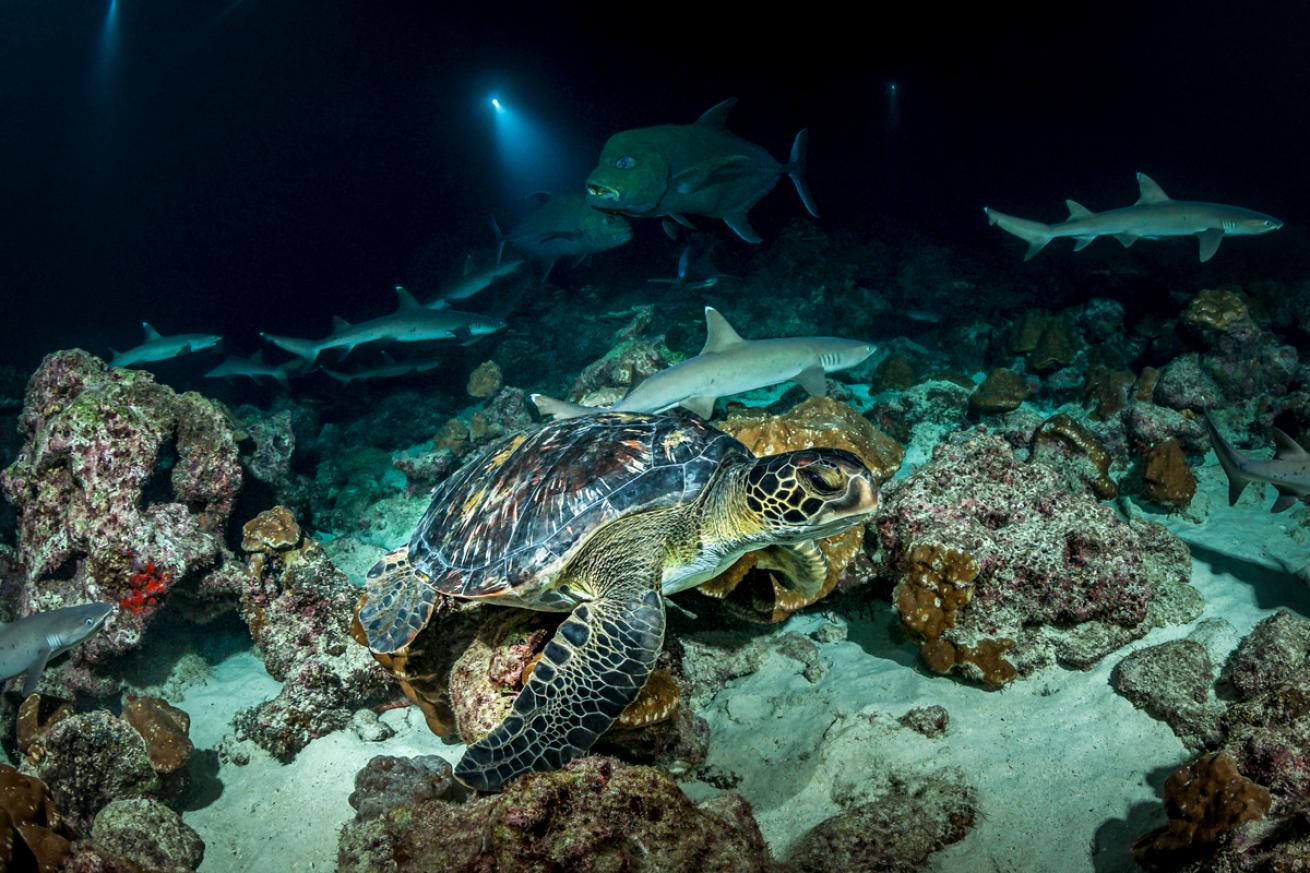
Tobias FriedrichA turtle sits on the sea floor.
Thanks to these well-marked (for them) paths, the animals move easily between the “Shark Triangle,” a moniker sometimes used to refer to the three island hammerhead hotspots off Central and South America.
“This shows us pretty much what we expected: that this is a shared population of sharks between Cocos, Malpelo and the Galapagos,” says Arauz.
It’s a wild thought—one I keep in mind the day we dive Small Dos Amigos right at the height of a ripping current, led by Okeanos I captain Mauricio Marin Cajina. We drop in and drop down to 65 feet. Immediately, we are surrounded by action.
Galapagos, hammerhead, silky, hammerhead, hammerhead.
It’s nonstop. We hold onto the rocks and just watch, careful to avoid urchins.
Cajina had warned us during the briefing that the urchins find a perfect position and just wait.
“They wait for Klaus, they wait for Brooke, they wait for Megan.” His eyes crinkle in laughter as he drills home his point—about their points, which have already broken skin on a handful of divers.
With each dip of the psi needle, the sharks grow bolder, coming in closer.
One species doesn’t need any time to acclimate to our presence. He’s bold right out of the gate, swimming directly toward me. Only when I straighten my posture, thrusting my face out in his direction, does he dart past, 2 inches away.
Back on the boat, Cajina tells me that if I hadn’t made that move, the shark would have come in even closer. The Galapagos, with their yellow cat eyes, know no fear. Only curiosity.
Which, in a way, makes sense for an animal that has spent a lifetime in three protected areas.
But, Arauz argues that the safety of the Galapagos shark, along with hammerheads, is seriously threatened if we are only protecting the islands where we as humans encounter them. It’s that magnetic corridor that matters most.
“You can keep your kids safe at home and then you make it so they are safe at school, but you wouldn’t send your kids to school on a route where they would get mugged or run over,” he says.
Right now, the kids are getting run over.
To change this, Arauz is working with the U.S.-based nonprofit Fins Attached Marine Research and Conservation, as well as CREMA, a Costa Rican nonprofit, to save this corridor. His work is supported and funded by nonprofit marine conservation organizations such as Save our Seas Foundation, the Whitley Fund for Nature, SeaLegacy, the Sandler Foundation and Ocean Blue Tree.
“If we don’t connect these protected areas, we will run out of sharks,” he says.
For him, it’s that simple.
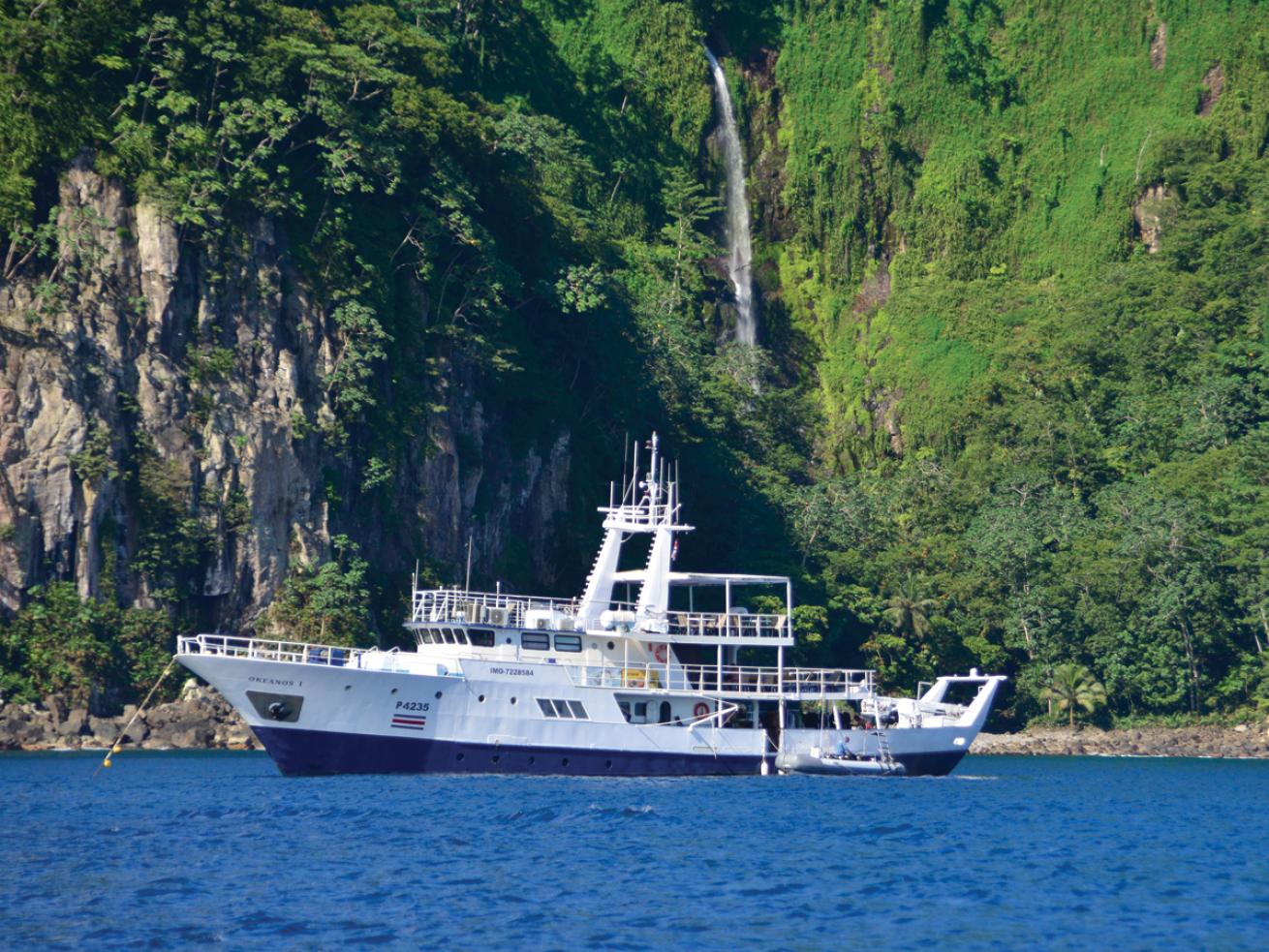
Courtesy ImageOkeanos Aggressor I
It’s a fight he believes he has a chance of winning if enough people support the cause and persuade Costa Rica’s current presidential administration to finish what it started before its term ends in 2022.
That win would be the biggest shift of all in this ecosystem, ushering back in schools of countless hammers. It’s a change we could see in our lifetimes—something that would silence every old-timer, all the divers who are quick to say, “You should have been here 20 years ago,” of their favorite destinations.
Even Arauz dips a toe into the should-have-been-here-when water when he recalls aloud: “There was a time when the schools of hammerheads were so big, you couldn’t count them.”
Numbers can’t help but matter. They tell us if we are winning the fight.
On my Aggressor trip, I was gobsmacked to see 60, even 70 during one dive—a sight I didn’t think possible.
But now, thanks to Arauz, I’m not content with those numbers, big as they are. I’m ready for the future. I want to stand in the face of the next old-timer and before he can say, “You should have been there—”
I’m going to cut him off. I’m going to tell him, “Yes, but have you been to Cocos lately? It’s going off. The best it has ever been is right now.”
Need To Know
Okeanos Aggressor I will retire on Dec. 31st, 2022. Those interested in a liveboard trip to Cocos Island can read about the new Cocos Island Aggressor here.
When to Go September and October are the rainiest months but also the best time of year to see schools of hammerheads.
Getting There Fly to San Jose, Costa Rica, and stay overnight—it’s required—in either the Park Inn by Radisson; Aggressor Adventures’ passenger van and luggage truck collect guests at both locations before the three-hour drive to Puntarenas.
Dive Conditions Water temperatures average about 82 degrees, with thermoclines dipping into the low 70s. Visibility is just 50 to 60 feet during peak season; it’s compromised by plankton, however, which is the reason all these predators are here.
Suggested Training PADI’s Advanced Open Water Diver would be the minimum recommended training. However, given the currents present on every single dive, the Drift Diver certification is preferred. Divers should carry and know how to use a surface-marker buoy and know how to make a hot drop from a dinghy.
Price Tag Aggressor Adventures offers 10-day trips offers 10-day trips aboard Okeanos Aggressor I starting at $5,399 for shared occupancy in a four-person cabin; the per-person charge for a twin cabin is $5,499; deluxe is $5,799. Okeanos Aggressor II is the newer vessel of the two, with rates starting at $5,799 per person for 10-day trips, based on double occupancy; master $6,099, and suites $6,799. On both boats, all meals and guided dives are included. A $490 per-person park fee is a separate, required charge, as is the $150 nitrox surcharge.
Join The Campaigns
“In no country in Latin America are sharks wildlife,” says Randall Arauz, marine conservation policy officer for Fins Attached Marine Research and Conservation.
Hard to believe someone like Arauz would make a statement like this, right?
Well, that’s because of semantics, and how fishery departments have found a clever loophole to exclude sharks from environmental protections. Labeling sharks as “commercial species” effectively means that their monetary value in the pockets of fishermen supersedes their rights as wild animals.
To support Arauz’s shark conservation efforts in Cocos, head to cremacr.org, where you will find more details about the Costa Rican conservation nonprofit CREMA and the Sharks Are Wildlife campaign. Sign the letter to Costa Rica’s President Carlos Alvarado Quesada, asking him to protect Costa Rica’s sharks from extinction at change.org.
You can also make a financial contribution in any amount through CREMA’s website. The funds that are received through donations directly support conservationist’s field work in Costa Rica.


